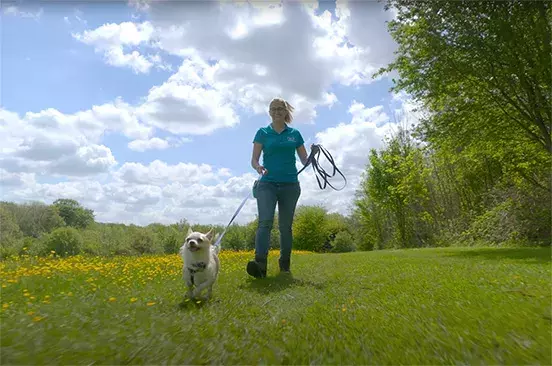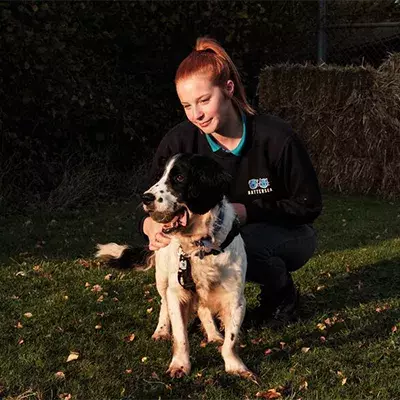Dogs are naturally social creatures who often love to play together, and for most dogs, meeting other dogs when out on walks is extremely common. Some dogs are happy to be sociable, while other prefer their own space and will be more comfortable with dogs who can respect their boundaries.

If your dog displays anxious or aggressive behaviour around other dogs, we would recommend getting in touch with a qualified canine behaviourist for help. Anxious and aggressive behaviours come from a place of fear, and a scared dog won’t simply get used to meeting other dogs over time. You may find our advice on “Dog Body Language” helpful in understanding whether your dog is anxious or fearful of other dogs, and our How to Find a Trainer or Behaviourist advice will give you some tips on how best to approach this issue going forward.
There are a few steps you can take when walking your dog to make sure any dog to dog interactions are as positive as possible for everyone involved.
Meeting Other Dogs While on the Lead
Get your dog used to Loose-Lead Walking
Loose-lead walking, exactly as it sounds, is when your dog is comfortable and not pulling on the lead, meaning you’re able to hold the lead loosely at your side. If your dog is on a loose lead you are more in control and can shorten a lead or more easily redirect your dog and take them in a different direction, for example, if you need to. We recommend practicing loose lead walking with all dogs wherever possible. Take a look at How to Teach your Dog to Walk on a Lead and How to Stop Your Dog Pulling on The Lead pages for more advice.
Practice Good Manners
Always check if it’s OK for your dog to say ‘hello’ when passing other dogs on the lead, rather than just allowing them to approach. Dogs who like to be sociable will naturally choose to approach one another side-on in an arc as opposed to head-on, so wherever possible, try to allow for this. When dogs meet face-to-face they’re more likely to give each other direct eye contact, which some dogs see as confrontational, so it’s best to avoid this in order to give the correct first impression.
If the owner asks you not to let your dogs meet, don’t be offended. Their dog may be anxious, or recovering from surgery, or they may simply be in a hurry; it’s nothing personal. If this happens, give the other dog as much room to pass as possible, even if this means crossing to the other side of the road. Where possible, keep your dog’s attention on you until the other dog passes, so your dog is less likely to become frustrated and the other dog is not put under any extra pressure. A watch me is a really useful command for this kind of situation. Take a look at our advice on How to Teach Watch Me for tips.
Use the Three-Second Rule
If the other owner says it’s OK for your dogs to meet, get into a position where your dog’s lead is relaxed so the dogs can interact normally, and they aren’t straining on the lead. Remember, face to face dog greetings can cause tension, so allow both dogs to circle towards the other dog’s rear end from side on, and keep things brief to begin with. Move around with your dog as they circle to make sure the leads don’t tangle. It’s best to position yourself next to your dog’s shoulder. This means you can keep your lead loose while the dogs interact, but you’re also close enough to gain control of your dog quickly if you need to.
Keep introductions short by following the “three second rule”; count to three as the dogs sniff each other, say thanks or nice to meet you to the owner, and then excitedly call your dog away and continue your walk. Keep praising your dog for walking away with you and reward them with a tasty treat like chicken for coming away from such a tempting distraction! By keeping interactions short you can make sure the experience stays positive for both dogs.
Look Out for Signs of Frustration
Simply stopping your dog from meeting other dogs when out and about without offering alternative treats or rewards, can sometimes lead to frustration. You might find your dog will whine, bark, pull, lunge and scramble on the lead to get to other dogs to say ‘hello’. Frustration is a problem behaviour as it makes for an unpleasant walking experience from the human end of the lead, as well as often having the opposite desired effect, as other owners keep their dogs away from yours, misinterpreting the behaviour as aggression. If your dog is frustrated about being on the lead but seems generally happy to be social with dogs take a look at our advice on “How to Overcome Lead Frustration”
Meeting Other Dogs While Off Lead
If your dog doesn’t come back when called and runs up to every dog they see, ignores other dogs’ social cues or will not listen to their warnings, then it’s important to try and manage their behaviour, otherwise they could potentially become a nuisance, or get themselves in to a bad situation.
Teach a Strong Recall
Before your dog is let off lead you need to be confident they will come back to you when called, no matter what the distraction. This gives you more control over interactions with other dogs, but also keeps you and your dog safe in the eyes of the law, as a dog that does not come back to its owner when called can be deemed “dangerously out of control”. You can find more about teaching a recall with Teach your dog a recall. The key to successful recall is finding what motivates your dog best when outdoors and making sure that you and whatever you are holding, are seen as the most appealing and most fun thing they can see. This will often mean using food or treats your dog really, really loves, such as chicken, cheese, hotdogs or liver cake, or a favourite toy (something squeaky can be good) only used on walks so the novelty of the item doesn’t wear off and it’s always exciting.
Find the right match for your dog’s personality
Dogs normally understand each other better than we do, as most of them are naturally good at reading the subtle cues in canine body language that we humans often miss. Different dogs will play in different ways and often, (but not always) different breeds will play differently. For example, sighthounds usually love chase games and can become quite vocal and nippy in their play; collies like to stalk and chase, and bull breeds tend to wrestle and joust. It is important to remember that not every playful dog will appreciate the play style of others. Finding the right match for your dog will be key in keeping the interaction positive for all involved. Well-matched, social dogs interact with each other in a balanced way. This means they will naturally take short breaks in play, swap “roles” during chase and wrestling games, and will take cues from each around how rough or intense the play should be.
Let your dog say no
Dogs may occasionally tell each other off during interactions. It is a form of communication and should be listened to and respected by the other dog. Never punish your dog for growling at another dog. Interactions between dogs should be well balanced and enjoyed by both dogs, and if your dog is not enjoying the interaction and has already tried the more subtle “polite” ways of asking the other dog to tone it down and been ignored, then growling is their next option. However, if your dog growling at other dogs is a regular occurrence or you are concerned in any way, we would suggest getting in touch with a qualified behaviourist.
Try a long-line lead first
To begin with, try using a 5, 10, 15 or 20m long-line lead attached to a harness that trails on the ground when on walks. This will give your dog the freedom to move around and explore the environment whilst still leaving you with some control over them. Never attach a long line to a dog’s collar as this could be dangerous if they reach the end of the lead at speed and are suddenly pulled backwards. Find more information about using a long line leads.
Find some dog role models
If you know people with social, well-behaved dogs who can act as a role model to yours, it is often a good idea to walk your dog with them so your dog can practise manners and social skills with some dog friends. Bear in mind that it will be frustrating for your dog to remain on lead if the others are all off the lead so if possible have the whole gang stick to lead walks and/or use the long-line to begin with. Keep practising the “three second rule” with greets and make sure to keep rewarding all calm behaviour in the presence of other dogs.
Teach your dog proper walking etiquette
It’s important your dog isn’t always let off lead to run around even if they are social, as you need them to be able to stay calm in the presence of other dogs when on lead; remember, just because your dog wants to say “hi” doesn’t mean the other dog feels the same way!
If your dog is off lead and you see a dog that is on lead, it is polite practise to call yours away and temporarily pop them back on lead to allow the other dog to pass in peace. Do bear in mind that other owners may be working hard on training programmes of their own, and having strange dogs run up to them can cause set-backs in their progress. Remember, if your dog finds it difficult to come away when called and is likely to ignore you and approach strange dogs, keep one step ahead of this behaviour using a harness and long-line. Ensure you maintain your dog’s attention on walks by trying to remain more exciting and stimulating that the surrounding environment; play tuggy games (keeping them close to you as opposed to fetch games that put distance between you and your dog), encourage them to chase you (as opposed to the other way around), scatter food in the grass for them to sniff out and find, or go through some basic tricks with them, but keep it all fun!
Don’t punish your dog
Never shout at your dog or punish them in any way when they see dogs as this could build a negative association with the presence of other dogs. This could in turn cause a negative emotional response to dogs and cause them to react defensively or aggressively towards them. If your dog is off lead being sociable and the other dog is also off lead and receptive to your dog, allow them to meet naturally. If either dog looks uncomfortable, ensure you can call and walk your dog away, praising and rewarding them heavily for making the right choice – no matter how long it took them to do so.


